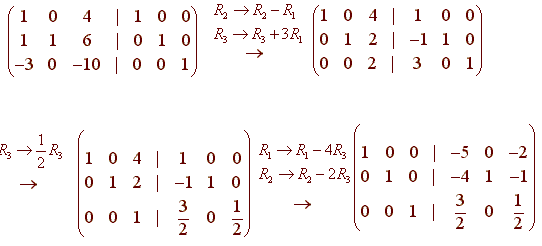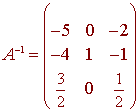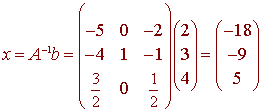Inverse of a Matrix
Definition and Examples
Recall that functions f and g are inverses if
f(g(x)) = g(f(x)) = x
We will see later that matrices can be considered as functions from Rn to Rm and that matrix multiplication is composition of these functions. With this knowledge, we have the following:
Let A and B be n x n matrices then A and B are inverses of each other, then
AB = BA = In
Example
Consider the matrices

We can check that when we multiply A and B in either order we get the identity matrix. (Check this.)
Not all square matrices have inverses. If a matrix has an inverse, we call it nonsingular or invertible. Otherwise it is called singular. We will see in the next section how to determine if a matrix is singular or nonsingular.
Properties of Inverses
Below are four properties of inverses.
- If A is
nonsingular, then so is A-1
and
(A-1) -1 = A
- If A
and B
are nonsingular matrices, then
AB
is nonsingular and
(AB) -1 = B-1A-1
-1
- If A
is nonsingular then
(AT) -1 = (A -1)T
- If A
and B
are matrices with
AB = In
then A and B are inverses of each other.
Notice that the fourth property implies that if AB = I then BA = I.
The first three properties' proof are elementary, while the fourth is too advanced for this discussion. We will prove the second.
Proof that (AB) -1 = B -1 A -1
By property 4, we only need to show that
(AB)(B -1 A -1) = I
We have
(AB)(B -1 A -1) = A(BB -1)A -1 associative property
= AIA-1 definition of inverse
= AA-1 definition of the identity matrix
= I definition of inverse
Finding the Inverse
Now that we understand what an inverse is, we would like to find a way to calculate and inverse of a nonsingular matrix. We use the definitions of the inverse and matrix multiplication. Let A be a nonsingular matrix and B be its inverse. Then
AB = I
Recall that we find the jth column of the product by multiplying A by the jth column of B. Now for some notation. Let ej be the m x 1 matrix that is the jth column of the identity matrix and xj be the jth column of B. Then
Axj = ej
We can write this in augmented form
[A|ej]
Instead of solving these augmented problems one at a time using row operations, we can solve them simultaneously. We solve
[A | I]
Example
Find the inverse of the matrix

Solution

The inverse matrix is just the right hand side of the final augmented matrix

This example demonstrates that if A is row equivalent to the identity matrix then A is nonsingular.
Linear Systems and Inverses
We can use the inverse of a matrix to solve linear systems. Suppose that
Ax = b
Then just as we divide by a coefficient to isolate x, we can apply A-1 to both sides to isolate the x.
A-1Ax = A-1b
Ix = A-1b x = A-1b
Example
Solve
x + 4z = 2
x + y + 6z = 3
-3x - 10z = 4
Solution
We put this system in matrix form
Ax = b
with

The solution is
x = A-1 b
We have already computed the inverse. We arrive at

The solution is
x = -18 y = -9 z = 5
Notice that if b is the zero vector, then
Ax = 0
can be solved by
x = A-10 = 0
This demonstrates a theorem
Theorem of Nonsingular Equivalences
The Following Are Equivalent (TFAE)
- A
is nonsingular
- Ax
= 0
has only the trivial solution
- A
is row equivalent to I
- The linear system Ax = b has a unique solution for every n x 1 matrix b
Back to the Matrices and Applications Home Page
Back to the Linear Algebra Home Page
Back to the Math Department Home Page
e-mail Questions and Suggestions